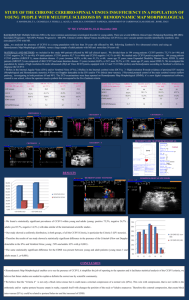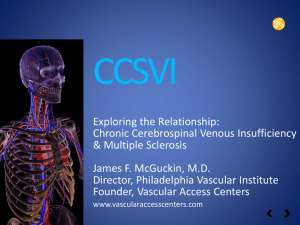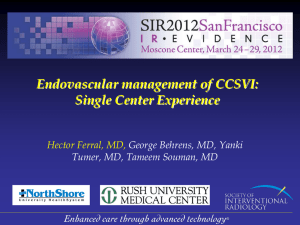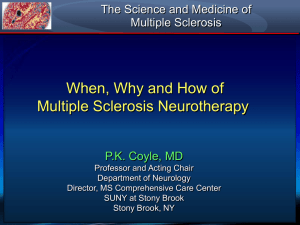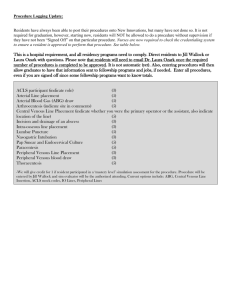RESPONSE TO REVIEWERS` COMMENTS REVIEWER AG Major
advertisement
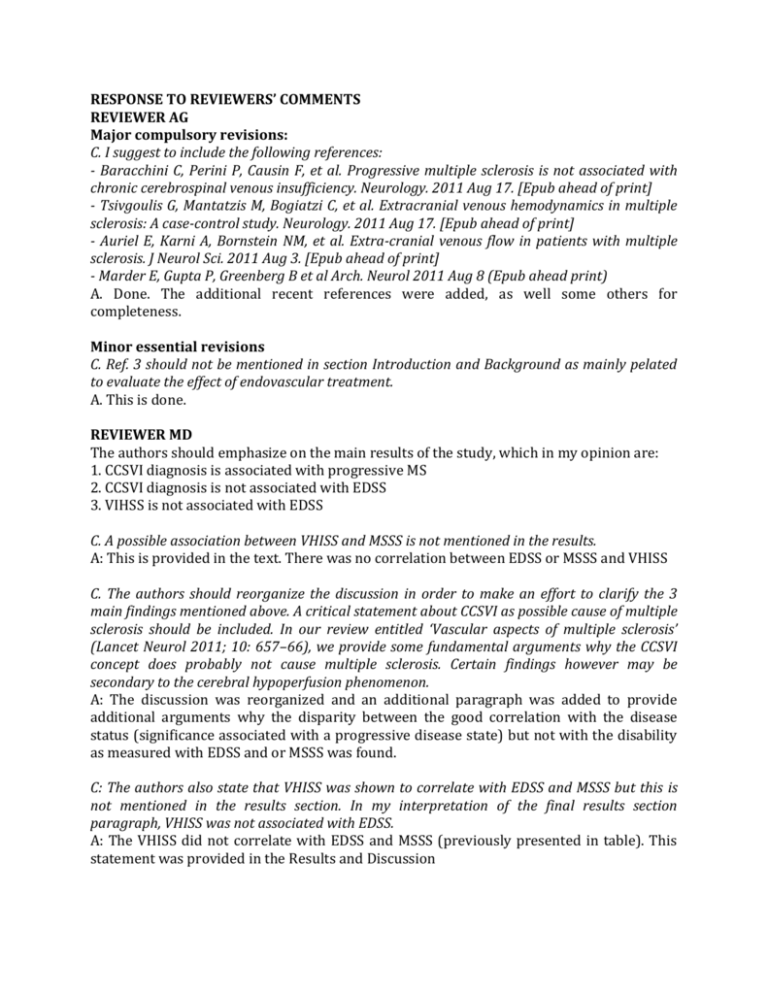
RESPONSE TO REVIEWERS’ COMMENTS REVIEWER AG Major compulsory revisions: C. I suggest to include the following references: - Baracchini C, Perini P, Causin F, et al. Progressive multiple sclerosis is not associated with chronic cerebrospinal venous insufficiency. Neurology. 2011 Aug 17. [Epub ahead of print] - Tsivgoulis G, Mantatzis M, Bogiatzi C, et al. Extracranial venous hemodynamics in multiple sclerosis: A case-control study. Neurology. 2011 Aug 17. [Epub ahead of print] - Auriel E, Karni A, Bornstein NM, et al. Extra-cranial venous flow in patients with multiple sclerosis. J Neurol Sci. 2011 Aug 3. [Epub ahead of print] - Marder E, Gupta P, Greenberg B et al Arch. Neurol 2011 Aug 8 (Epub ahead print) A. Done. The additional recent references were added, as well some others for completeness. Minor essential revisions C. Ref. 3 should not be mentioned in section Introduction and Background as mainly pelated to evaluate the effect of endovascular treatment. A. This is done. REVIEWER MD The authors should emphasize on the main results of the study, which in my opinion are: 1. CCSVI diagnosis is associated with progressive MS 2. CCSVI diagnosis is not associated with EDSS 3. VIHSS is not associated with EDSS C. A possible association between VHISS and MSSS is not mentioned in the results. A: This is provided in the text. There was no correlation between EDSS or MSSS and VHISS C. The authors should reorganize the discussion in order to make an effort to clarify the 3 main findings mentioned above. A critical statement about CCSVI as possible cause of multiple sclerosis should be included. In our review entitled ‘Vascular aspects of multiple sclerosis’ (Lancet Neurol 2011; 10: 657–66), we provide some fundamental arguments why the CCSVI concept does probably not cause multiple sclerosis. Certain findings however may be secondary to the cerebral hypoperfusion phenomenon. A: The discussion was reorganized and an additional paragraph was added to provide additional arguments why the disparity between the good correlation with the disease status (significance associated with a progressive disease state) but not with the disability as measured with EDSS and or MSSS was found. C: The authors also state that VHISS was shown to correlate with EDSS and MSSS but this is not mentioned in the results section. In my interpretation of the final results section paragraph, VHISS was not associated with EDSS. A: The VHISS did not correlate with EDSS and MSSS (previously presented in table). This statement was provided in the Results and Discussion C: The conclusion of the abstract should be that the presence and severity of CCVSI in multiple sclerosis has none or very limited association with clinical presentation. A. Changes are done. REVIEWER RF C: However, the discussion includes the statement, “VHISS was shown to correlate significantly with the clinical disability EDSS and MSSS as well as with most of the EDSS subscale scores (pyramidal, cerebellar, brainstem and sensory.” No statistics were provided in the Results section regarding correlation between the presence/absence of CCSVI and EDSS subscores – only table 3, which shows the comparison, but provides no analysis. In general, there is a significant disconnect between the Results shown and the conclusions drawn in the Discussion. A: The data and the corresponding statistical analysis was updated in the Results section. C: A deeper discussion is needed regarding the disconnect between disease stage and disability as they relate to CCSVI. Disease stage correlates well with CCSVI, but disability much less so (if at all). A: We provided an additional paragraph to try to provide additional arguments to explain the “disconnect” between disease stage vs. EDSS and relation to presence of venous hemodynamic abnormalities. Although our initial large prevalence data showed a significant association between disease stage (relapsing vs. progressive) and the presence of CSSVI (significantly higher in progressive patients), the disability data did not achieve significance. The divergence of the two data sets is only adding to the known difficulties to understand and measure the effects of MS double pathology, inflammatory vs. neurodegeneration, by introducing a new variable: the presence of a venous hemodynamic dysfunction. While both processes can lead to disability, the hemodynamic venous dysfunction associated rather with secondary tissue hypoperfusion may be linked to a continuous neurodegenerative process as seen in progressive disease stages and less related to the inflammatory aspects of the disease that may be primarily responsible for a more rapidly but also potential reversible disability. Additional comments: 1. The adjustment for multiple comparisons at p=0.01 needs more formal justification. The 60 comparisons in table 3 suggest that 0.01 is not sufficient adjustment. A: We agree with the Reviewer’s comment in general. However, when this study was planned, we did not know a-priori how many comparisons we would make, thus, we did not adjust the significance tests for multiple comparisons. In our post-hoc assessments, while there are multiple p-values reported, the questions are multiple. Corrections can be applied when there is a common question, when multiple variables are all looking for the same association. Moreover, such adjustments do not change the p-values, but rather the critical value for declaring that differences are statistically significant. However, we accept this generic concern and in order to avoid too many spurious findings, we correct the manuscript to not report any finding as statistically significant unless the nominal p-value was ≤0.01. This conservative approach should allow readers to make their own decisions and adjustments. 2. There are many typographical errors throughout the manuscript. A: These are corrected. 3. Much of the Table 2 legend has no relevance to the content of Table 2. A: The legend is edited. 4. The correlations between VHISS and EDSS subscores should be shown, not just cited as a p-value. A: This is provided. 5. The relevance of ANM to CCSVI needs to be more clearly stated, or removed entirely. A: We modified the text to introduce more explicit the notion of progressive myelopathy secondary to venous stasis. 6. The disclosures are incomplete: the authors currently perform CCSVI testing as a clinical service, with direct charges to MS patients. This is a relevant disclosure that should be included. A: Actually we do not. At some point, we had had IRB approved fee-for-service registry study that was designed to enhance utilization of data on venous anomalies that are obtained on individuals who have sought information on CCSVI status. This study is no longer active. REVIEWER BB 1. In the Abstract, the sentence beginning with “This analysis…” is unclear, as it does not indicate whether the authors are referring to the current manuscript or the manuscript discussed in the sentence prior. The concluding statement of the abstract is also misleading. The correlations between CCSVI is not with “presentation” (as this often refers to initial manifestations)- rather it is with current MS disease state (relapsing, secondary progressive, or primary progressive course). A: This was corrected. 2. It is unclear why the authors elected to retain the 21 CIS patients and 10 pediatric MS patients. Neither group is discussed in any detail subsequently. Of the 21 CIS participants, how many meet the 2010 MS diagnostic criteria? How many have isolated optic neuritis (with normal brain MRI) or other demyelinating presentations with a lower likelihood of future confirmation of MS? If the CIS group are truly a mixed population with variable likelihood of future MS diagnosis, the added value of including them is questionable. The pediatric patients should either be discussed or removed. A: In the revised manuscript the analysis was restricted to adults MS patients, RR, SPMS and PPMS. 3. The authors are reporting a clinical paper. Yet they do not address important clinical variables that could influence venous flow, such as any relationships between CCSVI or any specific component and (i) blood pressure; (ii) concurrent medications (especially antihyptertensives or other vasoactive medications; (iii) fluid status at the time of ultrasound (were participants instructed on consumption of fluids prior to ultrasound?); or (iv) smoking. A: In regard to hydration status, the ultrasound procedures were already described in the original publication (Zivadinov R, Marr K, Cutter G, Ramanathan M, Benedict RH, Kennedy C, et al. Prevalence, sensitivity, and specificity of chronic cerebrospinal venous insufficiency in MS. Neurology 2011; 77: 138-44). All subjects were required to have a good hydration status prior to examination (16 oz of water within 2 to 3 hours of doppler). In the original paper we also described that history of cerebral congenital vascular malformations (Klippel-Trenaunay, Parkes-Weber, Servelle-Martorell, Budd-Chiari, syndromes) was an exclusion criteria. The relationship between blood pressure or vasocative medications and clinical outcomes is beyond the scope of this manuscript, in our opinion. Future studies will report risk factors for CCSVI in MS patients from the CTEVD study. 3. The authors should remove any mention of “cure” in the introduction. Such statements are inappropriate in any context relating to CCSVI. A: This is removed. 4. The authors use the term “venous anomalies” frequently. Most people reserve such a term for structural abnormalities. While some aspects of ultrasound findings in the CCSVI analyses do discuss venous valve abnormalities and structural narrowing, other components relate solely to venous flow. Flow findings would not be an “anomaly” in most contexts. A. The venous anomalies could be structural or functional. Our paper in press (Dolic K, Marr K, Valnarov V, Dwyer M, Carl E, Karmon Y, et al. Intra- and extra-luminal structural and functional venous anomalies in multiple sclerosis, as evidenced by two non-invasive imaging techniques AJNR Am J Neuroradiol in press) will provides more light on this argument. 5. In the Analysis section, the sentence beginning with “Multinomial logistic….” Is unclear. What is “Control-Non-progressive MS-Progressive”? A: This was modified. 6. How were “relapsing” vs “non-relapsing” SPMS and PPMS patients defined? What was the time interval from last relapse that led to consideration of a patient being “non-relapsing”? A: The new analysis was performed on all SPMS (with and without relapses) and PPMS (primary progressive and progressive relapsing) 7. Despite an association between SPMS and PPMS and CCSVI, the EDSS score was not correlated. This important discrepancy should be further discussed. A: An additional paragraph was provided. 8. Most of the Discussion either repeats the authors prior findings, or focuses on theories for CCSVI that were not evaluated by the authors nor supported by any literature. All such text is extraneous to the present study and should be removed A: The discussion was reorganized.
